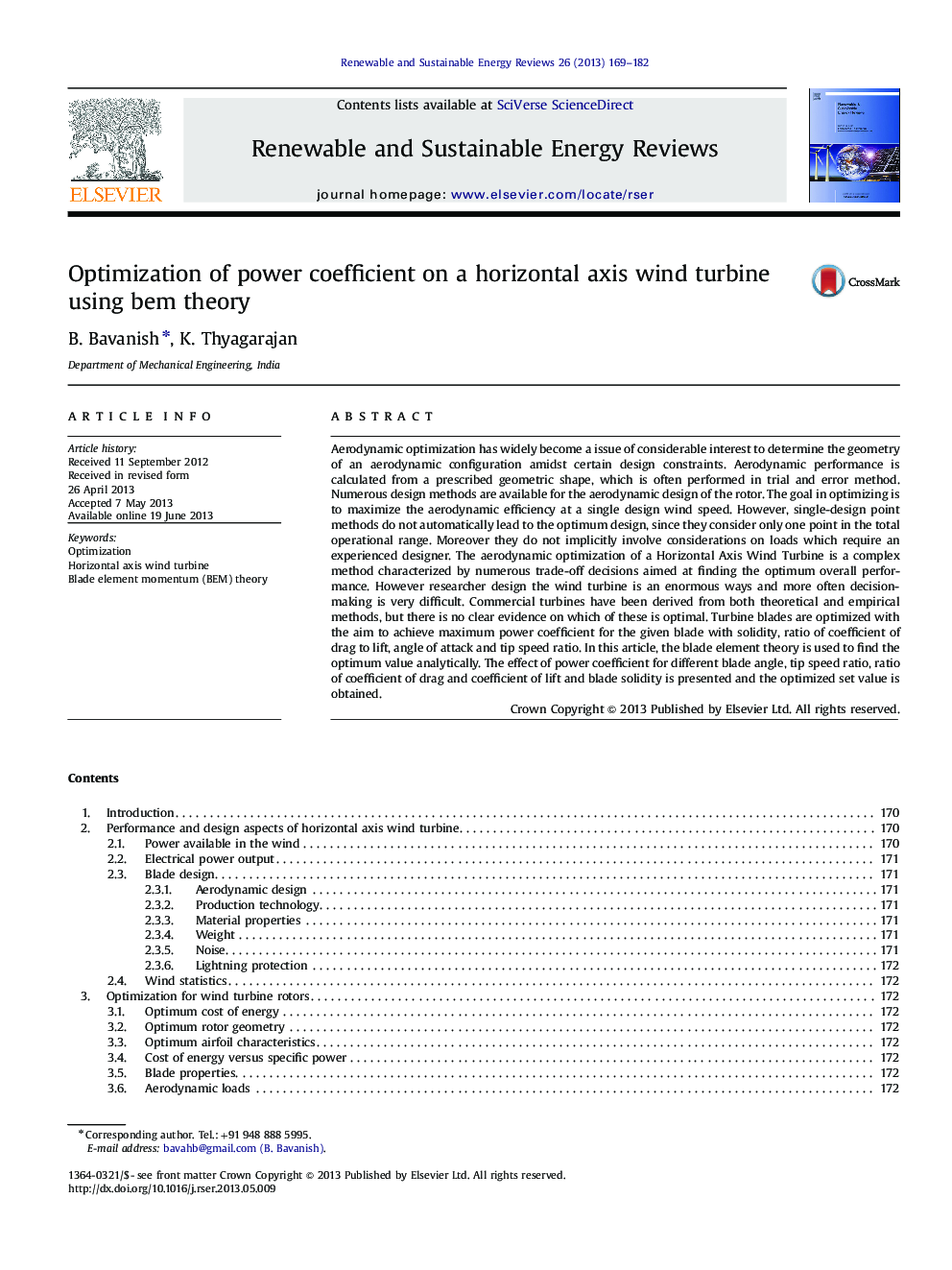| کد مقاله | کد نشریه | سال انتشار | مقاله انگلیسی | نسخه تمام متن |
|---|---|---|---|---|
| 8121292 | 1522359 | 2013 | 14 صفحه PDF | دانلود رایگان |
عنوان انگلیسی مقاله ISI
Optimization of power coefficient on a horizontal axis wind turbine using bem theory
ترجمه فارسی عنوان
بهینه سازی ضریب توان در توربین بادی محور افقی با استفاده از تئوری بم
دانلود مقاله + سفارش ترجمه
دانلود مقاله ISI انگلیسی
رایگان برای ایرانیان
ترجمه چکیده
بهینه سازی آئرودینامیکی به طور گسترده ای مورد توجه قابل توجهی برای تعیین هندسه یک پیکربندی آیرودینامیکی در میان محدودیت های طراحی خاص است. عملکرد آیرودینامیکی از یک شکل هندسی تجربی محاسبه شده است که اغلب در روش آزمایش و خطا انجام می شود. روش های مختلف طراحی برای طراحی آیرودینامیکی روتور در دسترس است. هدف در بهینه سازی این است که حداکثر بهره وری آیرودینامیکی را در یک سرعت باد طراحی طراحی کند. با این حال، روش نقطه تک طراحی به طور خودکار به طراحی مطلوب منجر نمی شود، زیرا آنها فقط یک نقطه در کل عملیاتی را در نظر می گیرند. علاوه بر این، آنها به طور ضمنی شامل ملاحظات در بارهای که نیاز به یک طراح با تجربه است. بهینه سازی آیرودینامیکی توربین بادی افقی محور، یک روش پیچیده است که با تصمیمات متعددی در مورد تصمیم گیری در جهت به دست آوردن عملکرد کلی بهینه در نظر گرفته شده است. با این حال محقق طراحی توربین بادی یک راه بسیار عظیم است و اغلب تصمیم گیری بسیار دشوار است. توربین های تجاری از روش های نظری و تجربی استخراج شده اند، اما هیچ شواهدی وجود ندارد که کدام یک از این ها مطلوب باشد. تیغه های توربین با هدف به دست آوردن حداکثر ضریب توان برای تیغه داده شده با استحکام، نسبت ضریب کشیدن به بالابر، زاویه حمله و نسبت سرعت نوک بهینه سازی شده است. در این مقاله، نظریه عنصر تیغه برای تعیین ارزش بهینه از لحاظ تحلیلی استفاده می شود. اثر ضریب قدرت برای زاویه تیغه، سرعت نوک سرعت، نسبت ضریب کشیدن و ضریب بالابر و استحکام تیغه ارائه شده است و مقدار مجموعه بهینه شده به دست آمده است.
موضوعات مرتبط
مهندسی و علوم پایه
مهندسی انرژی
انرژی های تجدید پذیر، توسعه پایدار و محیط زیست
چکیده انگلیسی
Aerodynamic optimization has widely become a issue of considerable interest to determine the geometry of an aerodynamic configuration amidst certain design constraints. Aerodynamic performance is calculated from a prescribed geometric shape, which is often performed in trial and error method. Numerous design methods are available for the aerodynamic design of the rotor. The goal in optimizing is to maximize the aerodynamic efficiency at a single design wind speed. However, single-design point methods do not automatically lead to the optimum design, since they consider only one point in the total operational range. Moreover they do not implicitly involve considerations on loads which require an experienced designer. The aerodynamic optimization of a Horizontal Axis Wind Turbine is a complex method characterized by numerous trade-off decisions aimed at finding the optimum overall performance. However researcher design the wind turbine is an enormous ways and more often decision-making is very difficult. Commercial turbines have been derived from both theoretical and empirical methods, but there is no clear evidence on which of these is optimal. Turbine blades are optimized with the aim to achieve maximum power coefficient for the given blade with solidity, ratio of coefficient of drag to lift, angle of attack and tip speed ratio. In this article, the blade element theory is used to find the optimum value analytically. The effect of power coefficient for different blade angle, tip speed ratio, ratio of coefficient of drag and coefficient of lift and blade solidity is presented and the optimized set value is obtained.
ناشر
Database: Elsevier - ScienceDirect (ساینس دایرکت)
Journal: Renewable and Sustainable Energy Reviews - Volume 26, October 2013, Pages 169-182
Journal: Renewable and Sustainable Energy Reviews - Volume 26, October 2013, Pages 169-182
نویسندگان
B. Bavanish, K. Thyagarajan,
